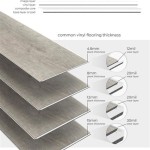Laying Vinyl Flooring on Concrete: A Comprehensive Guide
Vinyl flooring has gained immense popularity due to its durability, waterproof nature, and easy maintenance. When considering vinyl flooring installation, concrete subfloors are a common choice. Here's a comprehensive guide to help you successfully install vinyl flooring on a concrete surface:
1. Surface Preparation:
Proper surface preparation is crucial for a successful installation. Concrete surfaces should be level, smooth, and free of moisture. Grind down any high spots, fill in low areas with leveling compound, and ensure the surface is completely dry.
2. Moisture Testing:
Moisture can damage vinyl flooring, so testing the moisture content of the concrete is essential. Use a moisture meter or plastic vapor barrier test to ensure the concrete is under the recommended moisture level of 4%. If moisture levels are high, install a vapor barrier to prevent moisture penetration.
3. Underlayment Installation (Optional):
An underlayment can enhance comfort, reduce sound, and provide an additional moisture barrier. Choose an underlayment compatible with your vinyl flooring and the specific concrete surface conditions. Ensure proper installation per the manufacturer's instructions.
4. Adhesive Selection:
Choosing the right adhesive is critical for vinyl flooring to adhere properly to the concrete surface. Select an adhesive specifically designed for vinyl flooring installation on concrete. Consider factors such as the type of vinyl flooring and the moisture level of the concrete.
5. Vinyl Flooring Installation:
Start by laying out the vinyl planks or tiles according to the manufacturer's instructions. Apply adhesive to the designated areas on the concrete surface and immediately place the vinyl flooring pieces into position. Use a roller or tapping block to ensure the flooring is firmly adhered.
6. Seaming and Trimming:
For seamless transitions between vinyl flooring pieces, use heat welding or a click-lock system where applicable. Trim excess flooring around the edges using a utility knife or a flooring cutter for a clean and professional finish.
7. Grouting (If Necessary):
If you're using grout-jointed vinyl tiles, apply grout to the spaces between the tiles to seal and secure them. Ensure the grout is compatible with the vinyl flooring and follow the manufacturer's instructions for mixing and application.
8. Cleaning and Maintenance:
Once the vinyl flooring is installed, thoroughly clean the surface to remove any adhesive residue or debris. Regular maintenance, such as sweeping, mopping, and using a microfiber cloth, will keep the flooring looking its best for years to come.
Additional Tips:
- Allow the adhesive to cure fully according to the manufacturer's instructions before walking on or placing furniture on the vinyl flooring.
- Use heavy-duty mats or rugs in high-traffic areas to protect the vinyl flooring from scratches and wear.
- Avoid using harsh chemicals or abrasive cleaners on vinyl flooring, as they can damage its surface.
- If you encounter any damage, consult a professional flooring expert for repair or replacement.
Installing vinyl flooring on concrete can be a rewarding home improvement project. By following these steps, choosing the right materials, and paying attention to detail, you can create a durable, waterproof, and beautiful vinyl flooring solution that will enhance your living space for years to come.

How To Prepare A Concrete Floor For Vinyl Flooring Parrys

Easy Ways To Install Vinyl Plank Flooring On Concrete

How To Install Vinyl Or Laminate Floors In A Basement Over Concrete Slab

Easy Ways To Install Vinyl Plank Flooring On Concrete

Lvp Flooring Installation How To Install Luxury Vinyl Plank In A Basement Diy

Tips For Installing Vinyl Plank Over Concrete Floors Lemon Thistle

Laying Vinyl Planks The Right Way Expert Guide By Fantastic Handyman

How To Lay Vinyl Sheet Flooring On Concrete

Concrete Subfloor Preparation For The Vinyl Floor Installation How To Diy Mryoucandoityourself

How To Install Vinyl Flooring On Concrete Floor Ers
See Also







